2025 Cancer Reality Check: Your Action Plan Against Rising US Cases
📊 Shocking Stat: This year, over 2 million Americans will hear the words "you have cancer." Every single day, cancer claims approximately 1,700 lives nationwide. These aren't just numbers – they represent our families, friends, and neighbors. But here's the critical shift: 40% of these new diagnoses (over 811,000 cases!) are potentially preventable. Understanding the 2025 landscape isn't just informative; it's lifesaving.

🌎 State-by-State Risk: Where Do You Stand?
Cancer risk isn't equal across America. Where you live significantly impacts your likelihood of developing certain cancers, especially preventable ones like lung cancer.
- 📌 Lung Cancer Hotspot: Men in Kentucky face a lung cancer incidence rate of 98 per 100,000 – a staggering 3.5 times higher than men in Utah (28 per 100,000). Tobacco use, environmental factors, and access to screening are key drivers in these disparities.
- 📍 High-Burden States: California leads in sheer numbers (199,980 new cases), followed by Texas (150,870) and Florida (171,960). Population density and diverse risk factors, including lifestyle choices and health infrastructure, play major roles in these statistics.
- ✅ Action Step: Know your local risk! Check your state's specific cancer incidence data (like the examples above) and prevalent types. This knowledge empowers targeted prevention and early detection efforts. Ask your doctor: "What screenings are most critical for someone in my state and age group?" Engaging in conversations about your family's medical history can also provide valuable insights into your individual risk factors.
🔬 Breakthroughs & Hurdles: The 2025 Treatment Frontier
Treatment advances are driving real progress. The age-adjusted cancer death rate has plunged 34% since its 1991 peak, saving an estimated 4.5 million lives. This stems from:
- 💊 Precision Medicine: Tailoring treatments based on individual tumor genetics is yielding better outcomes with fewer side effects. Notably, therapies that target specific genetic mutations have revolutionized treatment for various cancer types, enhancing both effectiveness and patient quality of life.
- 🛡️ Immunotherapy Unleashed: Harnessing the body's own immune system to fight cancer continues to evolve, offering hope for previously untreatable cases. Breakthroughs such as CAR T-cell therapy and checkpoint inhibitors are examples of this remarkable progress, providing new hope for advanced cancer patients.
- ⚠️ The Cost Crisis: Despite progress, treatment costs are skyrocketing. Many life-saving drugs now exceed $100,000 annually, creating devastating financial toxicity for patients. Access to affordable, cutting-edge care remains a critical challenge, and many patients grapple with the burden of high co-pays and insurance limitations impacting treatment choices.
🛡️ Your Power: Prevention & Early Detection Saves Lives
Don't wait for symptoms. Proactive steps dramatically alter your cancer journey:
- 🚭 Slash Your Risk NOW: Quit smoking (causes 19% of cancers), maintain a healthy weight (prevents 8%), and limit alcohol (prevents 5%). These three changes alone tackle nearly a third of preventable cancers. Moreover, engaging in regular physical activity and a balanced diet rich in fruits and vegetables can further fortify your defenses against cancer.
- 🔍 Screen Religiously: Early detection is paramount. Survival rates plummet as cancer spreads. Participating in clinical trials may also provide access to innovative screening methods and treatments still in development.
- Breast: Annual mammograms starting at 40-44 (45-54 strongly recommended), transitioning to biennial or annual at 55+.
- Colorectal: Start at 45! Choose annual stool tests or periodic colonoscopy. Combining different screening approaches increases detection efficiency.
- Lung: Annual low-dose CT scans for adults 50-80 with a significant smoking history (20+ pack-years).
- Cervical: Primary HPV testing every 5 years (25-65) is preferred. The HPV vaccine can significantly reduce cervical cancer risk.
- Prostate: Men 50+ (earlier for high-risk) should discuss screening options with their doctor. Schedule your next recommended screening TODAY, as early detection plays a pivotal role in successful treatment outcomes.
🤝 Beyond Medicine: The Vital Role of Support & Equity
Facing cancer is overwhelming. Robust support systems and addressing disparities are non-negotiable:
- ⭐ Patient Lifelines: Navigation programs, transportation aid (like ACS Road To Recovery), lodging assistance, 24/7 helplines (1-800-227-2345), and mental health resources are crucial for holistic care. Peer support groups foster community and provide emotional solace in challenging times.
- ⚖️ Confronting Disparities: Tragic inequities persist. Black Americans face significantly higher mortality rates for prostate and breast cancers. American Indian/Alaska Native communities experience the highest overall cancer burden. It's essential to advocate for culturally competent care within healthcare systems. Systemic barriers to prevention, screening, and quality treatment must be dismantled. Support organizations focused on health equity in your community to further these efforts.
🔮 The Future: Turning Challenges into Cures
The path forward demands collective action:
- 📢 Ramp Up Prevention: Aggressive public health campaigns targeting smoking cessation, obesity, and HPV vaccination are essential investments. Community outreach programs can play a significant role in promoting awareness and education.
- 💡 Accelerate Innovation: Continued research funding is vital for next-gen therapies, early detection tools (like liquid biopsies), and understanding resistance. Collaboration between research institutions and healthcare providers can expedite the translation of discoveries into clinical practices.
- 🏢 Ensure Access for All: Advocating for policies that lower drug costs, expand insurance coverage, and eliminate geographic and racial barriers to care is paramount. Grassroots movements and community activism are critical in demanding change. Contact your representatives: Demand policies that make cancer prevention and treatment accessible and affordable for every American.
Your health is your most valuable asset. Arm yourself with knowledge, take proactive steps, demand equitable care, and join the fight. What action will YOU commit to this week? https://www.cancer.org/content/dam/cancer-org/research/cancer-facts-and-statistics/annual-cancer-facts-and-figures/2025/2025-cancer-facts-and-figures-acs.pdf https://acsjournals.onlinelibrary.wiley.com/doi/10.3322/caac.21871 https://www.cdc.gov/united-states-cancer-statistics/publications/uscs-highlights.html
